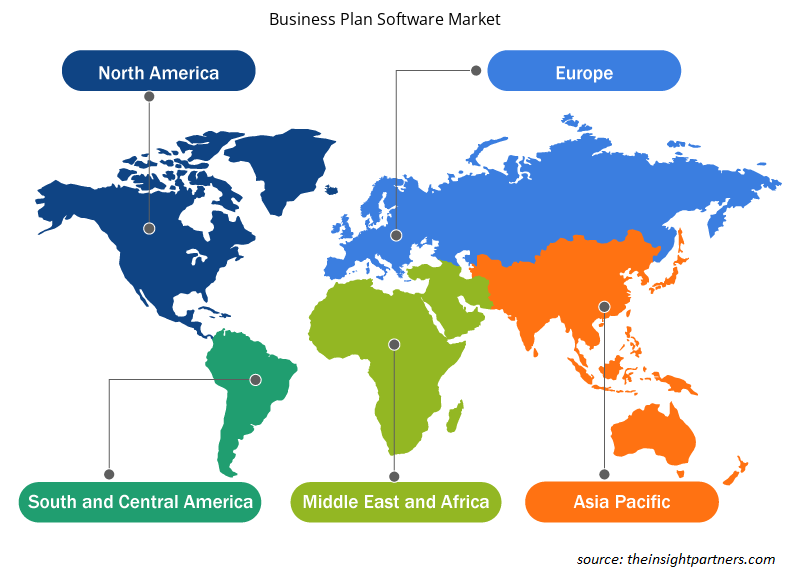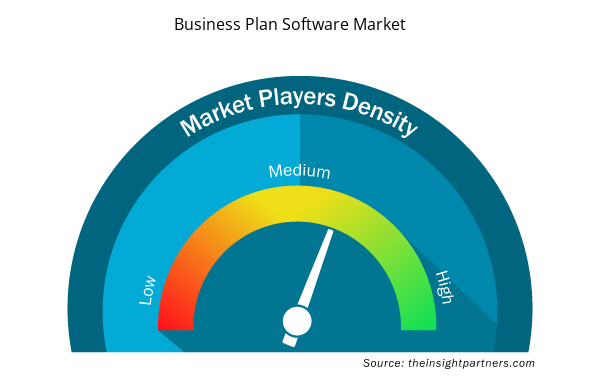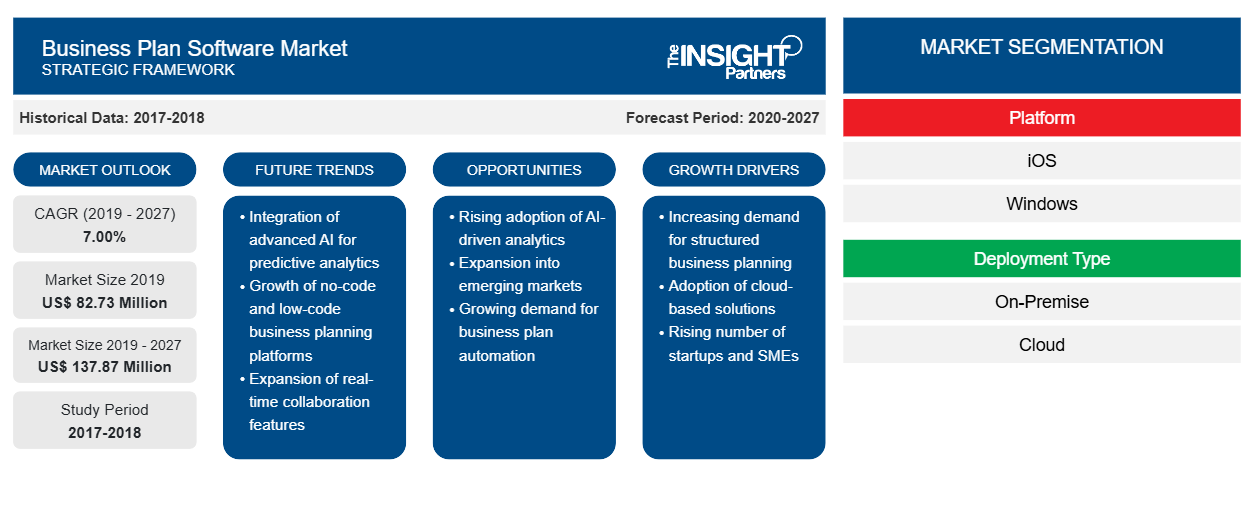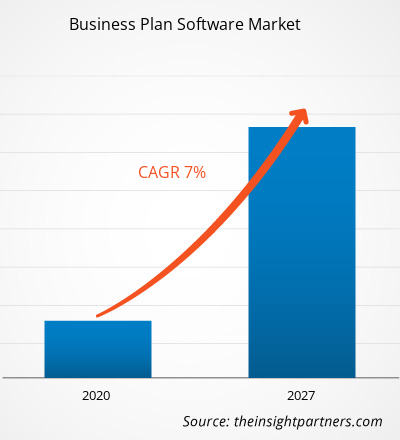Il mercato del software per piani aziendali è stato valutato a 82.730,3 mila dollari USA nel 2019 e si prevede che raggiungerà i 13.7871,4 mila dollari USA entro il 2027. Si prevede che il mercato del software per piani aziendali crescerà a un CAGR del 7,00% durante il periodo di previsione dal 2020 al 2027.
Il mercato del software per piani aziendali sta guadagnando importanza nel corso degli anni in tutto il mondo. Sia i paesi sviluppati che quelli in via di sviluppo stanno sperimentando una crescita significativa nel numero di start-up emergenti con imprenditori esperti di tecnologia. La domanda di software per piani aziendali è massima tra i nuovi imprenditori nei paesi sviluppati; tuttavia, gli imprenditori emergenti stanno acquisendo consapevolezza in relazione ai vantaggi del software per piani aziendali basato su software. Ciò sta catalizzando la crescita del mercato del software per piani aziendali. Il software per piani aziendali disponibile sul mercato è utilizzato anche da diverse società di consulenza che offrono servizi di pianificazione aziendale. Queste società di consulenza registrano un numero enorme di imprenditori che ogni anno cercano solidi piani aziendali in tutti i settori. Per quanto riguarda l'aumento della domanda di piani aziendali da parte di settori verticali diversificati, le società di consulenza optano per piani basati su software che li facilitano con una vasta gamma di esempi di piani aziendali. Ciò li aiuta ad acquisire un'enorme base di clienti e a pagare l'importo dell'abbonamento. Questo fattore spinge la crescita del mercato del software per piani aziendali.
Sebbene vi siano diversi punti di vista sui danni che il COVID-19 potrebbe causare, resta il fatto che il COVID-19 si sta diffondendo in tutto il mondo. I nuovi casi stanno aumentando in luoghi tra cui Stati Uniti, Canada, Europa, Africa, Medio Oriente, India, Australia, Corea del Sud, India e Giappone, tra molti altri paesi. Sebbene gli impatti sulle diverse attività siano ben noti, anche il settore tecnologico sta affrontando la più grande interruzione nella memoria recente
Il mercato globale del software per piani aziendali è segmentato in base a parametri quali piattaforma, tipo di distribuzione, tipo di abbonamento e geografia. In base alla piattaforma, il mercato è stato categorizzato come iOS, Windows e altri. Il segmento del tipo di distribuzione è stato suddiviso in on-premise e cloud. Il segmento del tipo di abbonamento è classificato come una tantum, mensile e annuale. Geograficamente, il software per piani aziendali è segmentato come Nord America, Europa, Asia Pacifico (APAC), Medio Oriente e Africa (MEA) e Sud America (SAM).
Personalizza questo report in base alle tue esigenze
Riceverai la personalizzazione gratuita di qualsiasi report, comprese parti di questo report, o analisi a livello nazionale, pacchetto dati Excel, oltre a usufruire di grandi offerte e sconti per start-up e università
- Scopri le principali tendenze di mercato in questo rapporto.Questo campione GRATUITO includerà analisi di dati che spaziano dalle tendenze di mercato alle stime e alle previsioni.
Approfondimenti di mercato sul software per piani aziendali
Accentuare il numero di start-up
La crescita straordinaria dell'industrializzazione globale è il risultato del crescente numero di start-up, piccole e medie imprese (PMI) e grandi organizzazioni in tutti i settori. L'ecosistema delle start-up sta vivendo un boom nello scenario attuale in tutto il mondo e sta guidando l'economia di ogni paese. I nuovi imprenditori cercano servizi di businessplanning per valutare le loro prospettive di business. Considerando il fatto che la maggior parte degli imprenditori emergenti nei paesi sviluppati è ben consapevole dei vantaggi della pianificazione aziendale basata su software, la domanda di software per business plan tra le aziende che forniscono servizi di business planning è in forte aumento. Questo parametro sta influenzando positivamente la crescita del mercato del software per business plan.
Approfondimenti di mercato basati sulla piattaforma
Le aziende che sviluppano software per la pianificazione aziendale si stanno concentrando in modo significativo sullo sviluppo dei loro prodotti per varie piattaforme. I software iOS, Windows, Linux e basati sul Web sono disponibili in abbondanza per facilitare i nuovi imprenditori o i nuovi titolari di attività a determinare e valutare la rispettiva roadmap aziendale. Gli altri segmenti (basati sul Web e Linux) dominano il mercato del software per la pianificazione aziendale, seguiti dal segmento Windows e dal segmento iOS.
Approfondimenti di mercato basati sul tipo di distribuzione
Il software per business plan basato su cloud, così come il software per business plan on-premise, stanno guadagnando popolarità tra i nuovi imprenditori e le società di consulenza che offrono servizi di business planning. Il segmento cloud genera la maggior parte della domanda poiché è relativamente meno costoso e grazie alla solida infrastruttura di rete nei paesi sviluppati. Inoltre, le aziende che sviluppano software per business plan si stanno concentrando molto sulla progettazione di una patch di sicurezza di alto livello per eliminare il rischio di attacchi informatici. Questo fattore sta anche creando una domanda significativa da parte degli utenti finali, guidando così il mercato del software per business plan.
Approfondimenti di mercato basati sul tipo di abbonamento
L'ecosistema globale delle start-up è in forte espansione e ogni nuovo imprenditore cerca un piano di roadmap aziendale appropriato. Ciò ha portato a un aumento del numero di sviluppatori di software per piani aziendali in tutto il mondo. Questi sviluppatori lanciano i loro prodotti su base di abbonamento, come un abbonamento una tantum, un abbonamento mensile e un abbonamento annuale. La domanda per ciascuno dei tipi di abbonamento sopra menzionati è in costante aumento tra i diversi utenti finali. Il segmento del tipo di abbonamento annuale domina il mercato del software per piani aziendali, seguito dal segmento una tantum e dal segmento mensile.
I player che operano nel mercato del software per piani aziendali si concentrano su strategie, come iniziative di mercato, acquisizioni e lanci di prodotti, per mantenere le loro posizioni nel mercato del software per piani aziendali. Ecco alcuni sviluppi dei player chiave del mercato del software per piani aziendali:
A febbraio 2019, Upmetrics Business Planner è qui per aiutarti. Questa piattaforma semplificata e all-in-one consente ai clienti di creare piani aziendali personalizzati, bozze di proiezioni finanziarie e molto altro ancora. E ora è disponibile un abbonamento a vita in modo rapido e semplice con oltre il 95 percento di sconto a soli $ 24,99.
Approfondimenti regionali sul mercato del software per piani aziendali
Le tendenze regionali e i fattori che influenzano il mercato del software per piani aziendali durante il periodo di previsione sono stati ampiamente spiegati dagli analisti di Insight Partners. Questa sezione discute anche i segmenti e la geografia del mercato del software per piani aziendali in Nord America, Europa, Asia Pacifico, Medio Oriente e Africa e Sud e Centro America.

- Ottieni i dati specifici regionali per il mercato del software per piani aziendali
Ambito del rapporto di mercato del software per piani aziendali
| Attributo del report | Dettagli |
|---|---|
| Dimensioni del mercato nel 2019 | 82,73 milioni di dollari USA |
| Dimensioni del mercato entro il 2027 | 137,87 milioni di dollari USA |
| CAGR globale (2019 - 2027) | 7,00% |
| Dati storici | 2017-2018 |
| Periodo di previsione | 2020-2027 |
| Segmenti coperti | Per piattaforma
|
| Regioni e Paesi coperti | America del Nord
|
| Leader di mercato e profili aziendali chiave |
|
Densità degli attori del mercato: comprendere il suo impatto sulle dinamiche aziendali
Il mercato del software per piani aziendali sta crescendo rapidamente, spinto dalla crescente domanda degli utenti finali dovuta a fattori quali l'evoluzione delle preferenze dei consumatori, i progressi tecnologici e una maggiore consapevolezza dei vantaggi del prodotto. Con l'aumento della domanda, le aziende stanno ampliando le loro offerte, innovando per soddisfare le esigenze dei consumatori e capitalizzando sulle tendenze emergenti, il che alimenta ulteriormente la crescita del mercato.
La densità degli operatori di mercato si riferisce alla distribuzione di aziende o società che operano in un particolare mercato o settore. Indica quanti concorrenti (operatori di mercato) sono presenti in un dato spazio di mercato in relazione alle sue dimensioni o al valore di mercato totale.
Le principali aziende che operano nel mercato del software per piani aziendali sono:
- Soluzioni aziendali Atlas, Inc.
- enloop, Inc.
- Palo Alto Software, Inc.
- PlanGuru, LLC
- Pianificazione semplice
Disclaimer : le aziende elencate sopra non sono classificate secondo un ordine particolare.

- Ottieni la panoramica dei principali attori del mercato dei software per piani aziendali
Mercato del software per il business plan – per distribuzione
- In sede
- Nuvola
Mercato del software per il business plan – per piattaforma
- Finestre
- iOS
- Altri
Mercato del software per piani aziendali – per tipo di abbonamento
- Una volta
- Mensile
- Annuale
Mercato del software per il business plan – per area geografica
America del Nord
- NOI
- Canada
- Messico
Europa
- Francia
- Germania
- Russia
- Regno Unito
- Italia
- Resto d'Europa
Asia Pacifico (APAC)
- Cina
- India
- Giappone
- Australia
- Resto dell'APAC
MEA
- Arabia Saudita
- Emirati Arabi Uniti
- Sudafrica
- Resto del MEA
SAM
- Brasile
- Argentina
- Resto del SAM
Mercato del software per il business plan – Profili aziendali
- Soluzioni aziendali Atlas, Inc.
- enloop, Inc.
- Palo Alto Software, Inc.
- PlanGuru, LLC
- Pianificazione semplice
- Startup.com LLC
- Società
- Tarkenton.com
- Il Business Plan Shop Ltd.
- Misure in aumento
- Analisi storica (2 anni), anno base, previsione (7 anni) con CAGR
- Analisi PEST e SWOT
- Valore/volume delle dimensioni del mercato - Globale, regionale, nazionale
- Industria e panorama competitivo
- Set di dati Excel



Report Coverage
Revenue forecast, Company Analysis, Industry landscape, Growth factors, and Trends

Segment Covered
This text is related
to segments covered.

Regional Scope
North America, Europe, Asia Pacific, Middle East & Africa, South & Central America

Country Scope
This text is related
to country scope.
Domande frequenti
The business plan software market was dominated by North America. The North American region comprises the US, Canada, and Mexico. As per the 2019 Small Business Profile published by the Small Business Administration, small businesses in the US employ ~59.9 million of the population and represent over 95% of the country’s total businesses. However, in December 2018, the National Federation of Independent Business (NFIB) dropped to 104.4, which is its lowest since late-2016. As per the association, the increasing trade disputes, credit card debt, and growing fiscal deficit, are some of the key factors affecting the optimism among the country’s small businesses. Further, the survey conducted by NFIB also noticed a drop in the number of entrepreneurs willing to expand their businesses owing to current political uncertainty or economic conditions.
During the forecast period, the cloud segment led the business plan software market. This is due to the fact that the cloud-based software simplifies a business planning process with tailored business plan templates through better planning. This benefit has attracted a significant percentage of end users, and pertaining to the rising demand for cloud-based software, the majority of the business plan software market players are offering cloud-based products. In addition, the internet infrastructure has matured in developed countries and is flourishing in several developing countries, thereby, allow end users in both developed countries as well as developing countries to access the cloud-based business planning software. This factor is driving the business plan software market.
The stupendous growth in global industrialization is a result of the rising number of start-ups, small and medium enterprises (SMEs), and large organizations across industries. The start-up ecosystem is booming in the current scenario across the world, and is driving the economy of every country. The new entrepreneurs are seeking business-planning services to assess their business prospects. Considering the fact, that majority of the emerging entrepreneurs in the developed countries are well aware of the benefits of software-based business planning, the demand for business plan software among the companies providing business planning services is surging. This parameter is positively influencing the growth of the business plan software market.
Trends and growth analysis reports related to Technology, Media and Telecommunications : READ MORE..
The List of Companies - Business Plan Software Market
- Atlas Business Solutions, Inc
- enloop, Inc.
- Palo Alto Software, Inc.
- PlanGuru, LLC
- Simpleplanning
- Startups.com LLC
- StratPad Inc.
- Tarkenton.com
- The Business Plan Shop Ltd
- UpMetrics
The Insight Partners performs research in 4 major stages: Data Collection & Secondary Research, Primary Research, Data Analysis and Data Triangulation & Final Review.
- Data Collection and Secondary Research:
As a market research and consulting firm operating from a decade, we have published and advised several client across the globe. First step for any study will start with an assessment of currently available data and insights from existing reports. Further, historical and current market information is collected from Investor Presentations, Annual Reports, SEC Filings, etc., and other information related to company’s performance and market positioning are gathered from Paid Databases (Factiva, Hoovers, and Reuters) and various other publications available in public domain.
Several associations trade associates, technical forums, institutes, societies and organization are accessed to gain technical as well as market related insights through their publications such as research papers, blogs and press releases related to the studies are referred to get cues about the market. Further, white papers, journals, magazines, and other news articles published in last 3 years are scrutinized and analyzed to understand the current market trends.
- Primary Research:
The primarily interview analysis comprise of data obtained from industry participants interview and answers to survey questions gathered by in-house primary team.
For primary research, interviews are conducted with industry experts/CEOs/Marketing Managers/VPs/Subject Matter Experts from both demand and supply side to get a 360-degree view of the market. The primary team conducts several interviews based on the complexity of the markets to understand the various market trends and dynamics which makes research more credible and precise.
A typical research interview fulfils the following functions:
- Provides first-hand information on the market size, market trends, growth trends, competitive landscape, and outlook
- Validates and strengthens in-house secondary research findings
- Develops the analysis team’s expertise and market understanding
Primary research involves email interactions and telephone interviews for each market, category, segment, and sub-segment across geographies. The participants who typically take part in such a process include, but are not limited to:
- Industry participants: VPs, business development managers, market intelligence managers and national sales managers
- Outside experts: Valuation experts, research analysts and key opinion leaders specializing in the electronics and semiconductor industry.
Below is the breakup of our primary respondents by company, designation, and region:

Once we receive the confirmation from primary research sources or primary respondents, we finalize the base year market estimation and forecast the data as per the macroeconomic and microeconomic factors assessed during data collection.
- Data Analysis:
Once data is validated through both secondary as well as primary respondents, we finalize the market estimations by hypothesis formulation and factor analysis at regional and country level.
- Macro-Economic Factor Analysis:
We analyse macroeconomic indicators such the gross domestic product (GDP), increase in the demand for goods and services across industries, technological advancement, regional economic growth, governmental policies, the influence of COVID-19, PEST analysis, and other aspects. This analysis aids in setting benchmarks for various nations/regions and approximating market splits. Additionally, the general trend of the aforementioned components aid in determining the market's development possibilities.
- Country Level Data:
Various factors that are especially aligned to the country are taken into account to determine the market size for a certain area and country, including the presence of vendors, such as headquarters and offices, the country's GDP, demand patterns, and industry growth. To comprehend the market dynamics for the nation, a number of growth variables, inhibitors, application areas, and current market trends are researched. The aforementioned elements aid in determining the country's overall market's growth potential.
- Company Profile:
The “Table of Contents” is formulated by listing and analyzing more than 25 - 30 companies operating in the market ecosystem across geographies. However, we profile only 10 companies as a standard practice in our syndicate reports. These 10 companies comprise leading, emerging, and regional players. Nonetheless, our analysis is not restricted to the 10 listed companies, we also analyze other companies present in the market to develop a holistic view and understand the prevailing trends. The “Company Profiles” section in the report covers key facts, business description, products & services, financial information, SWOT analysis, and key developments. The financial information presented is extracted from the annual reports and official documents of the publicly listed companies. Upon collecting the information for the sections of respective companies, we verify them via various primary sources and then compile the data in respective company profiles. The company level information helps us in deriving the base number as well as in forecasting the market size.
- Developing Base Number:
Aggregation of sales statistics (2020-2022) and macro-economic factor, and other secondary and primary research insights are utilized to arrive at base number and related market shares for 2022. The data gaps are identified in this step and relevant market data is analyzed, collected from paid primary interviews or databases. On finalizing the base year market size, forecasts are developed on the basis of macro-economic, industry and market growth factors and company level analysis.
- Data Triangulation and Final Review:
The market findings and base year market size calculations are validated from supply as well as demand side. Demand side validations are based on macro-economic factor analysis and benchmarks for respective regions and countries. In case of supply side validations, revenues of major companies are estimated (in case not available) based on industry benchmark, approximate number of employees, product portfolio, and primary interviews revenues are gathered. Further revenue from target product/service segment is assessed to avoid overshooting of market statistics. In case of heavy deviations between supply and demand side values, all thes steps are repeated to achieve synchronization.
We follow an iterative model, wherein we share our research findings with Subject Matter Experts (SME’s) and Key Opinion Leaders (KOLs) until consensus view of the market is not formulated – this model negates any drastic deviation in the opinions of experts. Only validated and universally acceptable research findings are quoted in our reports.
We have important check points that we use to validate our research findings – which we call – data triangulation, where we validate the information, we generate from secondary sources with primary interviews and then we re-validate with our internal data bases and Subject matter experts. This comprehensive model enables us to deliver high quality, reliable data in shortest possible time.


 Ottieni un campione gratuito per questo repot
Ottieni un campione gratuito per questo repot